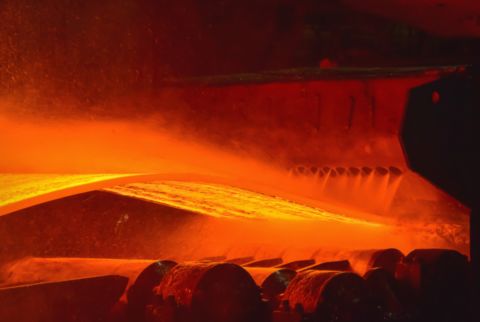Within the UMNIK project support contest, young scientists from the SUSU Institute of Engineering and Technology are developing an automated electric drive for rolling mills. The developed system can increase manufacturers’ profits by reducing equipment breakdowns and mill shutdowns. This is a continuation of research from previous years, and the scientists have already achieved significant results in this field.
The rolling cage is the main piece of equipment of a rolling mill since rolling is completed inside the cage itself. The design of the cage significantly affects the performance of the rolling mill: productivity, product quality, and energy and material resource use. Using MatLab, SUSU scientists analysed the working modes of the main drive of a rolling cage and developed a mathematical model of it.
When the metal is caught by the thick plate mill, additional impact loads are applied to the cage body, which increases the dynamic load on the rolling cage.
“The rolling cage of a thick plate mill is characterized by high loads which can reach 6·106 Nm during rolling, and the strength of rolling can reach 12000 tons. These loads can lead to premature destruction of rolls, couplings, gears, spindle and its components,” said Ekaterina Gartlib, staff member of the Department of Electric Drive, Mechatronics, and Electrical Engineering.
The scientists’ development is unique in that a neural network is used to calculate the rolling moment and drawdown. There are only three similar rolling cages in the world (two are in Russia, one is in China), none of which use intelligent systems. The scientists believe that the automation system can be used on other hot rolling cages to reduce dynamic momentum.
“Experimental data obtained on a Mill 5000 rolling cage at PAO MMK (Magnitogorsk Iron & Steel Works) showed that high dynamic load leads to rapid wear of this equipment and, consequently, to unintentional downtime and loss of profits,” said the scientist.
In the future, the scientists plan to develop an automated electric drive system using a neural network that can calculate the pre-loading of rolls based on data coming from the cage sensors. This will reduce the dynamic load when the metal is being gripped in sheet rolling mills.
The automated electric drive system will find its application in the metallurgical industry in roll production. Winning the UMNIK contest earned the scientists funding to develop their project to the amount of 500 thousand roubles.
“Grant contests are an opportunity to meet like-minded people and to learn how to present yourself, your projects, and your ideas. It opens up the possibility to turn a project into an established production, gaining the support of other people. You can go beyond research and learn something new for yourself and develop certain competencies and skills,” said Ekaterina Gartlib.
South Ural State University is a university of transformations, where innovative research is conducted in most of the priority fields of science and technology development. In accordance with the strategy of scientific and technological development of the Russian Federation, the university is focused on the development of big scientific interdisciplinary projects in the field of digital industry, materials science, and ecology. In 2021 SUSU became the winner in the competition under the Priority 2030 program. The university acts as a regional project office of the World-class Ural Interregional Research and Education Centre (UIREC), which is aimed at solving the tasks of the Science and Universities National Project.
Read our news:




